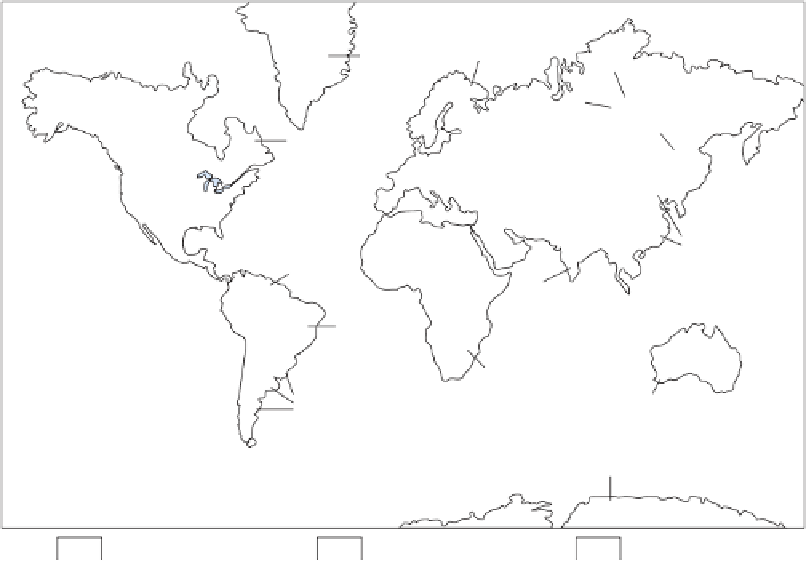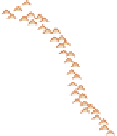Geology Reference
In-Depth Information
?
Heat
is an important agent of metamorphism because it
increases the rate of chemical reactions that may produce
minerals different from those in the original rock. Heat may
come from extrusive lava, intrusive magma, or as a result of
deep burial in the crust due to subduction along a conver-
gent plate boundary.
When rocks are intruded by bodies of magma, they are
subjected to intense heat that affects the surrounding rock;
the most intense heating usually occurs adjacent to the
magma body and gradually decreases with distance from
the intrusion. The zone of metamorphosed rocks that forms
in the country rock adjacent to an intrusive igneous body is
usually distinct and easy to recognize.
Recall that temperature increases with depth and that
Earth's geothermal gradient averages about 25°C/km. Rocks
that form at the surface may be transported to great depths
by subduction along a convergent plate boundary and thus
subjected to increasing temperature and pressure. During
subduction, some minerals may be transformed into other
minerals that are more stable under the higher temperature
and pressure conditions.
What Would You Do
As the director of a major museum, you have the opportunity
to purchase, for a considerable sum of money, a newly dis-
covered marble bust by a famous ancient sculptor. You want
to be sure it is not a forgery. What would you do to ensure
that the bust is authentic and not a clever forgery? After all,
you are spending a large sum of the museum's money. As a
nonscientist, how would you go about making sure that the
proper tests are performed to authenticate the bust?
same in all directions (
Figure 7.2a). A similar situation occurs
when an object is immersed in water. For example, the deeper
a cup composed of Styrofoam
TM
is submerged in the ocean,
the smaller it gets because pressure increases with depth and is
exerted on the cup equally in all directions, thereby compress-
ing the cup composed of Styrofoam
TM
(Figure 7.2b).
Along with lithostatic pressure resulting from burial,
rocks may also experience
differential pressure
(
◗
◗
Figure 7.3).
In this case, the stresses are not equal in all directions, but are
stronger from some directions than from others. Differential
pressures typically occur when two plates collide. In this case,
the horizontal stress from collision is greater than the vertical
stress from burial, resulting in distinctive metamorphic
textures and features in the affected rocks.
During burial, rocks are subjected to increasingly greater
pressure, just as you feel greater pressure the deeper you dive
in a body of water. Whereas the pressure you feel is known as
hydrostatic pressure
, because it comes from the water surround-
ing you, rocks undergo
lithostatic pressure
. This means that
the stress (force per unit area) on a rock in Earth's crust is the
In almost every region of metamorphism, water and carbon
dioxide (CO
2
) are present in varying amounts along min-
eral grain boundaries or in the pore spaces of rocks. These
fl uids, which may contain
ions in solution, enhance
metamorphism by in-
creasing the rate of chem-
ical reactions. Under dry
conditions, most miner-
als react very slowly, but
when even small amounts
of fluid are introduced,
reaction rates increase,
mainly because ions can
move readily through the
fluid and thus enhance
chemical reactions and
the formation of new
minerals.
The following re-
action provides a good
example of how new
minerals can be formed
by
fluid activity
. Seawater
moving through hot
basaltic rock in the oce-
anic crust transforms oliv-
ine into the metamorphic
mineral serpentine:
Baltic
Shield
Greenland
Shield
Siberian
Shield
Canadian
Shield
Chinese
Shield
Guiana
Shield
Indian
Shield
Brazilian
Shield
African
Shield
Patagonian
Shield
Australian
Shield
Antarctic
Shield
Precambrian shields
Younger rocks
Folded mountain belts
◗
Figure 7.1
Metamorphic Rock Occurrences Shields are the exposed portions of the crystalline
basement rocks underlying each continent. These areas have been very stable during the past 600 million
years. Metamorphic rocks also constitute the crystalline core of major mountain belts.






























































Search WWH ::

Custom Search